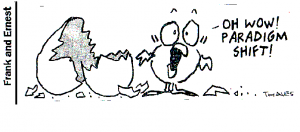Knock-Knock.
Who’s there?
Money.

Posted in Stephanie Kelton
Tagged #PCS, #TDC, MMT, Modern Monetary Theory, Money. Trillion Dollar Coint
The exception to the general pattern focusing on the Trillion Dollar Coin (TDC) as the solution to the debt ceiling problem I outlined and critiqued in my last post, is in Joe Wiesenthal ‘s posts here and here. Wiesenthal alone criticizes, rather than ignores, other options than the TDC, namely the $16 T and $100 T options, on grounds that they are no more effective at meeting the debt ceiling crisis than the TDC. He says that the issue is not a lack money but the debt ceiling law, and also that if a coin that large were minted and used to pay back the debt, then the result would be inflation or hyperinflation because of the flow of the large quantity of reserves into the economy, and the ensuing great expansion in the money supply. Continue reading
By J. D. Alt
*A work of fiction
 The President appeared surprisingly upbeat and confident: He grasped the sides of the lectern—not as he often had in the recent past, as if to support and steady himself in moments of national turmoil—but rather as if he were about to lift it up and toss it aside. Adjusting his papers, he quickly made eye-contact with each reporter in the front rows, usually with a quick nod of greeting, but sometimes with a stern hesitation. Continue reading
The President appeared surprisingly upbeat and confident: He grasped the sides of the lectern—not as he often had in the recent past, as if to support and steady himself in moments of national turmoil—but rather as if he were about to lift it up and toss it aside. Adjusting his papers, he quickly made eye-contact with each reporter in the front rows, usually with a quick nod of greeting, but sometimes with a stern hesitation. Continue reading
Posted in J. D. Alt
Tagged fiat currency, MMT, Modern Monetary Theory, sovereign currency
 Enthusiasm for using Platinum Coin Seigniorage (PCS) to produce a Trillion Dollar Coin, or coins totaling a few trillion dollars continues to increase. The twitterverse went mad two nights ago around #mintthecoin, a hashtag originated by MMT’s Stephanie Kelton, which by yesterday morning had become the 5th most highly trending topic on twitter.
Enthusiasm for using Platinum Coin Seigniorage (PCS) to produce a Trillion Dollar Coin, or coins totaling a few trillion dollars continues to increase. The twitterverse went mad two nights ago around #mintthecoin, a hashtag originated by MMT’s Stephanie Kelton, which by yesterday morning had become the 5th most highly trending topic on twitter.
Meanwhile, the blogosphere continued to produce more points of view on the Platinum Coin. The points of view divide into those that are very negative; either claiming that 1) using Platinum Coins would be illegal or unconstitutional, or 2) using them would be just ridiculous and financially irresponsible, and so should be avoided; and others that favor using PCS 3) either in a limited way to avoid the debt ceiling crisis, or 4) in a much more robust way, that would change the procedures underlying Federal spending, so that fiscal policies advocating austerity no longer have a political foundation in a visible and rising national debt that austerity advocates can constantly talk about fixing through “shared sacrifice.” In this post I’ll review new posts on legality and constitutionality. Continue reading
Another platinum coin surge in the Second Wave rippled through the mainstream media yesterday and this time hit the Congressional Progressive Caucus. Domenico Mantanaro of MSNBC kicked things off on one of the morning shows by mentioning the Trillion Dollar Coin (TDC) as a possible solution to the debt ceiling problem. Then, in the afternoon, on MSNBC’s the cycle, Krystal Ball, and Steve Kornacke, in discussing the coming debt ceiling conflict talked rather matter-of-factly, I thought, about minting some TDCs to get around the debt ceiling. Continue reading
[Part 1] [Part 2] [Part 3] [Part 4] […]
This five part series will explore at length (warning!) and in detail (another warning—wonk alert!) the MMT perspective on the debt ratio and fiscal sustainability. While the approach suggests a macroeconomic policy mix and strategies for both fiscal and monetary policies that most neoclassical economists currently believe are unsustainable, ultimately the MMT preference for a significant role for fiscal policy in macroeconomic stabilization is shown to be consistent with traditional neoclassical views on fiscal sustainability.
This fifth and final (!) part applies functional finance to CBO’s projections of the government’s long-term budget outlook and then offers concluding remarks for the entire series. Continue reading
Posted in Scott Fullwiler
Tagged debt ratio, functional finance, MMT, Modern Monetary Theory
Well, that’s over. The President had a chance to go “over the cliff,” bargain hard with the Republicans, get more of what he said he wanted at the price of perhaps some more days of crisis with extreme pressure building on the Republican caucus, and he blinked. I don’t much care that he blinked on tax rates for the top 2% and on inheritance taxes, because tax rate increases for purposes of deficit reduction simply aren’t needed for getting deficit spending needed to create jobs, as the rest of this post will show. Here’s what I care about: Continue reading
[Part 1] [Part 2] [Part 3] […] [Part 5]
This five part series will explore at length (warning!) and in detail (another warning—wonk alert!) the MMT perspective on the debt ratio and fiscal sustainability. While the approach suggests a macroeconomic policy mix and strategies for both fiscal and monetary policies that most neoclassical economists currently believe are unsustainable, ultimately the MMT preference for a significant role for fiscal policy in macroeconomic stabilization is shown to be consistent with traditional neoclassical views on fiscal sustainability.
This fourth part integrates the content of the first three parts with the functional finance strategy for fiscal policy. Warning again—this part is the longest and most detailed of the four. Continue reading
Posted in Scott Fullwiler
Tagged debt ratio, Fiscal Sustainability, MMT, Modern Monetary Theory
[Part 1] [Part 2] […] [Part 4] [Part 5]
This five part series will explore at length (warning!) and in detail (another warning—wonk alert!) the MMT perspective on the debt ratio and fiscal sustainability. While the approach suggests a macroeconomic policy mix and strategies for both fiscal and monetary policies that most neoclassical economists currently believe are unsustainable, ultimately the MMT preference for a significant role for fiscal policy in macroeconomic stabilization is shown to be consistent with traditional neoclassical views on fiscal sustainability.
This third part discusses the historical behavior of US interest rates on the national debt in the context of fiscal sustainability.
Posted in Scott Fullwiler
Tagged debt ratio, functional finance, MMT, Modern Monetary Theory